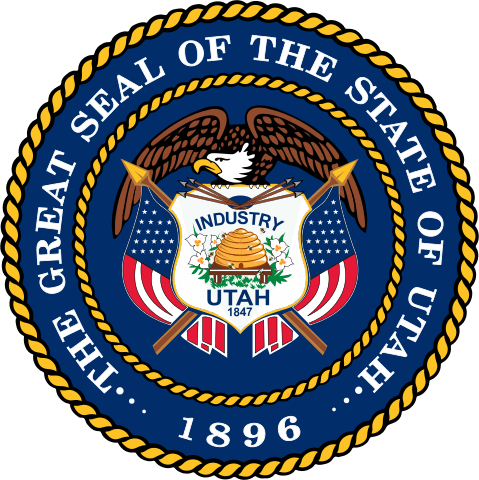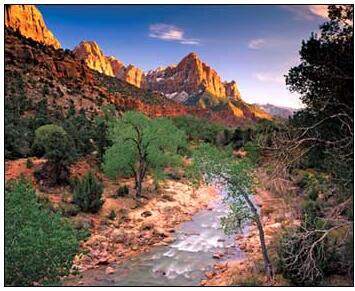Utah is a state in the United States of America. The capital of Utah is Salt Lake City. The abbreviation is UT, the nickname of the state is The Beehive State (English beehive, beehive ‘,’ bee state ‘,’ beehive ‘). The nickname is explained by the fact that the founding Mormons made the beehive as a symbol of industry to a symbol of the state or territory.
Other state symbols are the seagull as the state bird, the cherry as the state fruit, the Allosaurus as the state fossil and the Colt M1911 as the state weapon. Utah was the first state in which a weapon received this status.
The name Utah is derived from the Indian people of the Ute, who still live in Utah today, along with a few other peoples. It means “people of the mountains” in the Ute language. The Mormons wanted the state to be Deseret ; this religiously based name, which comes from the Book of Mormon, was not accepted by the American government because of the separation of church and state.
| Area | 219,887 km² |
| Residents | 3,051,218 |
| Residents per km² | 13.9 |
| Capital | Salt Lake City |
| Postal Code | UT |
| ISO-3166-2 code | US-UT |
| FIPS code | 49 |
Geography
Utah’s neighboring states are Nevada, Idaho, Wyoming, Colorado, New Mexico, and Arizona. The southeast corner of the state forms with the areas of Colorado, New Mexico and Arizona the only quadrangle of the United States, the point Four Corners, after which the adjacent region is named.
Extension of the national territory
The area of 219,887 km² extends over 435 kilometers from east to west between 109 ° W and 114 ° W, as well as 565 kilometers from south to north between 37 ° N and 42 ° N. 3.25 percent of the national territory consists of water, The Great Salt Lake has the largest share.
Climate
In Utah there is an extreme steppe climate, i. In other words, there are relatively hot summers around 30 ° C and cold, snowy winters often below 0 ° C. The annual rainfall ranges from 200 to 700 mm and is relatively evenly distributed throughout the year. The region around Salt Lake City (1350 m) is a popular winter sports area; The 2002 Winter Olympics were held here.
History
The Utah Territory (which was much larger than today’s Utah) was formed on September 9, 1850 from the northeastern part of the territory ceded by Mexico to the USA in the Treaty of Guadalupe Hidalgo in 1848. As early as 1847, Utah was colonized by the followers of the Church of Jesus Christ of Latter-day Saints (“Mormons”).
In the Utah War of 1857/58, however, the Mormons’ political power was crushed. In 1861, the new Nevada Territory was formed from the western part of the area and parts of the east were ceded to the Colorado Territory and the Nebraska Territory. In 1868 additional areas went to the state of Nevada and the Wyoming Territory.
Economy
The real gross domestic product per capita was USD 51,243 in 2016 (national average of the 50 US states: USD 57,118; national ranking: 29). The unemployment rate was 3.2% in November 2017 (national average: 4.1%).
Because of the largely desert-like landscape, arable farming in Utah is only possible near the mountains with irrigation or dry farming (wheat, sugar beets, potatoes, fruit). Livestock is kept (cattle, sheep). Mining (copper, oil, uranium ore, gold, salt, silver, lead, iron, natural gas, metals) as well as the aviation industry and tourism are important. The capital, Salt Lake City, was named No. 1 by the US magazine “Fortune” in 1990. 1 US City in which to do business ”because it has well-trained and motivated employees.
Utah Flag
The original flag of Utah was adopted by law in 1896 and underwent a change in 1913. The current flag dates from 1911 and shows the official seal from 1896. In 1913 this form of the flag was officially established.
Description
The beehive on the sign stands for hard work and diligence (eng. Industry). The beehive is also reminiscent of the emblem of the Mormon state of Deseret in Utah and the settlement of this region by the Mormons.
The year 1847 is the year the Mormons came to Utah. A bald eagle, the state bird of the USA, sits on the shield and symbolizes protection in times of peace and war. The lily symbolizes peace – it is a Calochortus nuttallii (called sego lily in English). The two US flags indicate Utah’s support for the nation. The flag of Utah in its current form was designed for the battleship Utah in 1912.
Great Salt Lake
The Great Salt Lake ( English Great Salt Lake) is a salt lake in northern Utah in the United States, whose salt content exceeds the sea far. The color caused by the salt content also makes the lake an eye-catcher from space.
The lake is about 1280 meters above sea level, about 120 kilometers long and 48 to 80 kilometers wide. It covers an area of around 4400 square kilometers. The depth of the lake is around 4.5 meters on average, the deepest point around 10 meters. The city of Salt Lake City was named after him, the city and its suburbs are located on the east coast of the lake. The great salt desert connects to the west and southwest.
The lake has three major tributaries: the Bear River and the Weber River flow from the Wasatch Range and the Uinta Mountains, and the Jordan River flows from Utah Lake to the south. The three rivers all flow into the southern part (Gilbert Bay), which means that the northern half of the lake (Gunnison Bay) is significantly salty. The salt content is around 9 percent in the southern part and around 25 in the northern part. Halophilic bacteria give the northern part a distinct red color. The lake is difficult to reach in many places as it is lined with tidal flats.
The main component of the dissolved salts is sodium chloride, i.e. table salt that is obtained in shallow artificial ponds for commercial purposes. It has been estimated that the lake contains around five billion tons of sodium chloride in dissolved form.
Water level
The water level of the lake can fluctuate greatly depending on the weather. On the one hand, there are annual fluctuations that depend on the seasons – the lake has its annual low in autumn. But there are also longer-term fluctuations to be followed. In heavily rainy years the water content increases, in dry years it can decrease rapidly, as water from the tributaries is used for the city and agriculture and therefore never reaches the lake.
The lowest water level measured so far (1963) was 1277 meters above sea level. NN., The highest, however, with 1284 meters above sea level. NN. in 1986 and 1987 about 7 meters higher. In recent years (2002/2003), however, the level has dropped sharply again. As a result, some of the salt mining sites have become islands in the middle of a salt desert. The level of the lake is a good indicator of the local climate.
As a result of the drainage of water in the lake’s tributaries for agriculture since the organized settlement in the mid-19th century, the lake has suffered great losses of water. Adjusted for seasonal fluctuations, the water level has since fallen by around 3.30 m (11 ft) and the volume of the lake by around 50%. As a result, the salt content rose by almost half and around half of the former area of the lake fell dry. This is associated with losses for economic uses, as well as the increase in dust in the air we breathe due to the mineral deposits being blown up on the former lake bed.
Habitat
Despite the maximum salt content of 27 percent, several species of creatures have been found in the lake, including many different saltwater shrimp. Gill pods such as brine shrimp are also present. The brine shrimp has been harvested in large numbers since the 1950s, also called Sea Monkey in this context, and sold as fish feed, among other things. Many water birds such as the California gull and insects feed on it.
Use
The lake is used economically in several ways. This includes the breakdown of salts and minerals such as potassium sulfate, magnesium chloride and table salt. Brine shrimp are also harvested. The neighboring cities and agriculture draw water from the lake. However, the lake was heavily polluted by the city and agriculture. The lake attracts tourists; there is also the option of sailing on the lake.
Also known as Beehive State, Utah is short for UT with a population of 2,233,169. The capital city and the biggest city of Utah is Salt Lake City.

